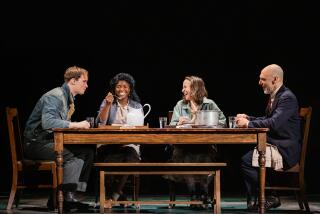STAGE REVIEW : ‘Voice of the Prairie’ Broadcasts Charming Tales From the Past
- Share via
SAN DIEGO — Prairie’s big. Farms are few --Voice of the Prairie
Storytelling in America, perhaps in the world, is a vanishing art. So they tell us. It’s been supplanted by flashing images, Emp-Tee-V, infotainment and other sorceries. Only Spalding Gray and Garrison Keillor remain on the American horizon to remind us of how truly bewitching the human story humanly told can be.
Even the tall story.
John Olive’s “The Voice of the Prairie,” which opened Saturday at the Old Globe’s Cassius Carter Centre Stage, is less tall story than fairy tale. Through its fantasy he has fashioned that rare thing: a small, skillful play with a deft heart.
It could have been the sentimental tale of a blind girl, Frankie (Lynne Griffin), and her itinerant companion, Davey (Sean Gregory Sullivan), as they wander the railroads of America, leaping and laughing, freight to freight. Instead, Olive makes that an aspect of the plot, woven into a much larger canvas: the birth of radio in America, 1895 to 1923.
“Voice” sets up dual journeys: Frankie’s and Davey’s--and that of the grown-up Davey, David Quinn (William Utay) and Leon Schwab (Sullivan).
Leon is a whiz-bang small-town entrepreneur who’s latest bright idea is starting a broadcasting business. He happens to overhear this farmer (Quinn) tell a story to a group of people and invites him to come tell it over that newfangled contraption: a microphone.
The bewildered farmer muddles through, and the germ of an idea is launched. A bond is also formed. From these hesitant beginnings, Quinn evolves into radio’s first major spellbinder, invited at the last to cast his spell in New York by none other than NBC’s David Sarnoff.
The “stories” he tells revolve around Quinn’s youthful travels with Frankie. She becomes, in absentia, as much of a mythic creature as the storyteller himself. What happened to the real Frankie you’ll have to find out for yourselves. There are curlicues to this plot--stories within stories--that are the colorful stuff Frank Capra movies are made of.
How real is it? It’s fiction, but a perfect demonstration of how fiction magnifies reality. “I wanted to explore the way a storyteller transforms the past, the way he takes liberties with events--lies, in other words--to create a more vivid truth in the present,” Olive writes in the program notes. It is precisely what makes “Voice of the Prairie” more than just an adventure.
In the mythological sense, this unsentimental but touching story of lives that collide more than they coalesce places the mystery and power of the spoken word in historical perspective. And at the same time that it extols the miracle of collective communication, it crucially juxtaposes the difficulty of the interpersonal one--between Frankie and Davey, Frances (Frankie grown-up) and David, David and Leon, Frances and James (an asthmatic, pious suitor who comes calling--but that’s another story).
The tangle of tales Olive has spun is less complicated than it sounds and borne aloft like a feather as much by his own spirited writing as by the exceptional three-person cast director Tom Bullard has assembled.
Griffin is entrancing--one moment the mirthful, exuberant adolescent Frankie, and the next a poised, imperceptibly stooped Frances, drowning in sadness. Her ability to convey blindness without the standard blank stare or rolled eyes is matched by her skill at conveying any age strictly through body language. Her emotional intensity is equally well calibrated--always exactly on the mark.
Utay’s David is a soulful, introspective man, full of self-doubt and unimpressed by his own publicity. He is also possessed of a voice born to mesmerize listeners. But this is not Gary Owens. The warmth is uncultivated.
Utay is a major contrast to the small, wiry Sullivan, who has the comic talents and physicalities of a skilled mime as well as the subtleties of a good actor. The combination of all three performers (who play more than one role or more than one age in one role) multiplies their power exponentially.
Bullard has staged all with dexterity. Production values (lights Wendy Heffner, sound Lucy Peckham, scenic and costume design Karen Gerson) are simple and effective. This “Voice” charms, uplifts and reminds us--if we needed reminding--of the magnitude of the trade-off that took place when we surrendered silken words to fast-moving pictures.
Performances at the Simon Edison Center for the Performing Arts in Balboa Park run Tuesdays through Saturdays at 8 p.m., Sundays at 7 p.m., with matinees Saturdays and Sundays at 2. Ends March 13. Tickets $17-$24; (619) 239-2255.
More to Read
The biggest entertainment stories
Get our big stories about Hollywood, film, television, music, arts, culture and more right in your inbox as soon as they publish.
You may occasionally receive promotional content from the Los Angeles Times.










